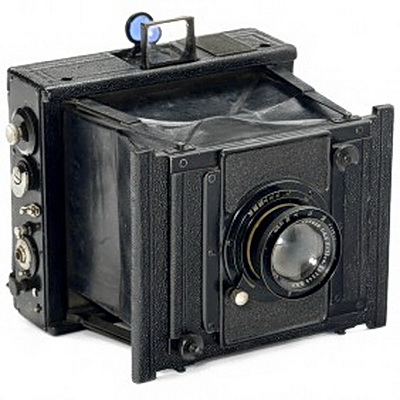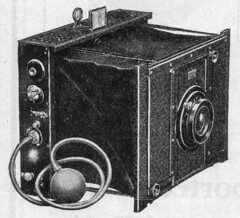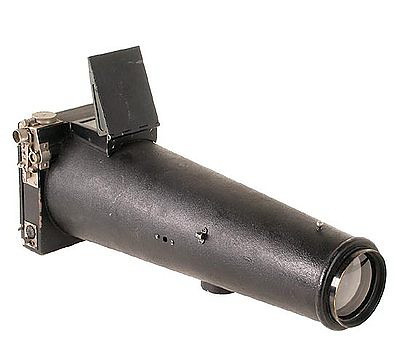Süleymandemir (talk | contribs) m (moved Goerz Anschütz ANGO to Goerz-Anschütz Ango) |
Süleymandemir (talk | contribs) (added photos) |
||
| Line 1: | Line 1: | ||
| − | [[File:Goerz_Ango.jpg|frame|Goerz |
+ | [[File:Goerz_Ango.jpg|frame|Goerz-Anschütz Ango c.1906]] |
| − | '''Goerz |
+ | '''Goerz-Anschütz Ango''' is a series of strut [[folding]] plate film [[medium format]] to [[large format]] camera manufactured by [[Goerz]], and produced between c.1896-1922.<ref>{{McKeown12}} p.354</ref> |
| − | Camera introduced in 1896 as a [[Anschütz]] camera. |
+ | Camera introduced in 1896 as a [[Goerz-Anschütz|Anschütz]] camera. |
| − | At early times, Goerz's specialty were cameras with the fast rouleau shutter that the company had licensed exclusively from its inventor Ottomar Anschütz from Lissa in Posen (at that time a province of Germany). |
+ | At early times, Goerz's specialty were cameras with the fast ''rouleau'' shutter that the company had licensed exclusively from its inventor Ottomar Anschütz from Lissa in Posen (at that time a province of Germany). |
A long running series of such cameras was named after 1905 as '''Ango''', an abbreviation for '''AN'''schütz and '''GO'''erz with some improvements. |
A long running series of such cameras was named after 1905 as '''Ango''', an abbreviation for '''AN'''schütz and '''GO'''erz with some improvements. |
||
| Line 10: | Line 10: | ||
Typical elements of these cameras were a set of controls at one side of the camera body since early focal plane shutters needed more than one control element to set the speed. A combination of slit width setting and rouleau speed setting gave the shutter speed. Until 1905 the slit width had to be set inside the camera. On the opposite side of the camera was its grip. |
Typical elements of these cameras were a set of controls at one side of the camera body since early focal plane shutters needed more than one control element to set the speed. A combination of slit width setting and rouleau speed setting gave the shutter speed. Until 1905 the slit width had to be set inside the camera. On the opposite side of the camera was its grip. |
||
| − | Reflex models were available as well as stereo models. |
||
A few variations for presentation models were made with red leather covering, crocodile covering and red bellows. A unique feature over other stereo cameras is that the separation of the lenses is variable so that the relief in the picture can be controlled. |
A few variations for presentation models were made with red leather covering, crocodile covering and red bellows. A unique feature over other stereo cameras is that the separation of the lenses is variable so that the relief in the picture can be controlled. |
||
| Line 25: | Line 24: | ||
|image= http://farm3.static.flickr.com/2391/1811175932_183f9efcba_m.jpg |
|image= http://farm3.static.flickr.com/2391/1811175932_183f9efcba_m.jpg |
||
|image_align= right |
|image_align= right |
||
| − | |image_text= Goerz |
+ | |image_text= Goerz-Anschütz Ango High-Speed |
<small>image by Uwe Kulick</small> |
<small>image by Uwe Kulick</small> |
||
|image_by= Uwe Kulick |
|image_by= Uwe Kulick |
||
| Line 31: | Line 30: | ||
}} |
}} |
||
| + | ==Other models== |
||
| − | *As '''High-Speed Ango''' it was still marketed in 1922, for plate sizes 3 1/4 x 4/1/4", 4x5", 5x7" and 10x15cm , and equipped with Goerz Dogmar f-4.5 lens. Other models were the Ango Jagd-Reflex, the Ango Luxus, the Ango Stereo and the Ango Stereo Luxus. |
||
| + | *Ango High-Speed it was still marketed in 1922, for plate sizes 9x12, 10x13, 10x15 and 13x18, with [[Goerz|Dogmar]] f/4.5 lens |
||
| − | |||
| + | *Ango Jagd-Reflex (German Jagd = hunting) |
||
| + | *Ango Luxus |
||
| + | *[[Goerz-Anschütz|Ango Stereo]] |
||
| + | *[[Goerz-Anschütz|Ango Stereo Luxus]] |
||
| Line 39: | Line 42: | ||
| + | {{Flickr_image |
||
| + | |image_source= http://www.flickr.com/photos/s-demir/6116139399/in/photostream |
||
| + | |image= http://farm7.static.flickr.com/6185/6116139399_2631a214de.jpg |
||
| + | |image_align= center |
||
| + | |image_text= Goerz-Anschütz Ango Jagd-Reflex <small>image by Süleyman Demir</small> |
||
| + | |image_by= Süleyman Demir |
||
| + | |image_rights= with permission |
||
| + | }} |
||
| + | {{Flickr_image |
||
| + | |image_source= http://www.flickr.com/photos/s-demir/6116137975/in/photostream |
||
| + | |image= http://farm7.static.flickr.com/6187/6116137975_ed0e519246.jpg |
||
| + | |image_align= center |
||
| + | |image_text= Goerz-Anschütz Ango Luxus <small>image by Süleyman Demir</small> |
||
| + | |image_by= Süleyman Demir |
||
| + | |image_rights= with permission |
||
| + | }} |
||
==Notes and references== |
==Notes and references== |
||
Revision as of 08:02, 6 September 2011

Goerz-Anschütz Ango c.1906
Goerz-Anschütz Ango is a series of strut folding plate film medium format to large format camera manufactured by Goerz, and produced between c.1896-1922.[1] Camera introduced in 1896 as a Anschütz camera.
At early times, Goerz's specialty were cameras with the fast rouleau shutter that the company had licensed exclusively from its inventor Ottomar Anschütz from Lissa in Posen (at that time a province of Germany).
A long running series of such cameras was named after 1905 as Ango, an abbreviation for ANschütz and GOerz with some improvements.
Typical elements of these cameras were a set of controls at one side of the camera body since early focal plane shutters needed more than one control element to set the speed. A combination of slit width setting and rouleau speed setting gave the shutter speed. Until 1905 the slit width had to be set inside the camera. On the opposite side of the camera was its grip.
A few variations for presentation models were made with red leather covering, crocodile covering and red bellows. A unique feature over other stereo cameras is that the separation of the lenses is variable so that the relief in the picture can be controlled.
Some features
- Lenses: mainly Dagor, Dogmar, Syntor, and Celor, crosshairs on the front lens
- Formats: more common 9x12, 10x15, 13x18cm
- Shutter: Ottomar Anschütz rouleau shutter as a focal plane shutter
- Viewfinder: collapsible optical Newton finder
- Characteristic type of struts

|
| Goerz-Anschütz Ango High-Speed
image by Uwe Kulick (Image rights) |
Other models
- Ango High-Speed it was still marketed in 1922, for plate sizes 9x12, 10x13, 10x15 and 13x18, with Dogmar f/4.5 lens
- Ango Jagd-Reflex (German Jagd = hunting)
- Ango Luxus
- Ango Stereo
- Ango Stereo Luxus

|
| Goerz-Anschütz Ango Jagd-Reflex image by Süleyman Demir (Image rights) |

|
| Goerz-Anschütz Ango Luxus image by Süleyman Demir (Image rights) |
Notes and references
- ↑ McKeown, James M. and Joan C. McKeown's Price Guide to Antique and Classic Cameras, 12th Edition, 2005-2006. USA, Centennial Photo Service, 2004. ISBN 0-931838-40-1 (hardcover). ISBN 0-931838-41-X (softcover). p.354
Links
- in Historic Camera
- Anschütz Kameras of Goerz at www.ottomar-anschuetz.deC[1]
- Goerz Anschutz 13x18 at Sylvain Halgand's www.collection-appareils.fr